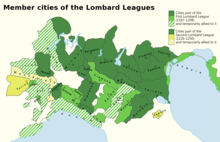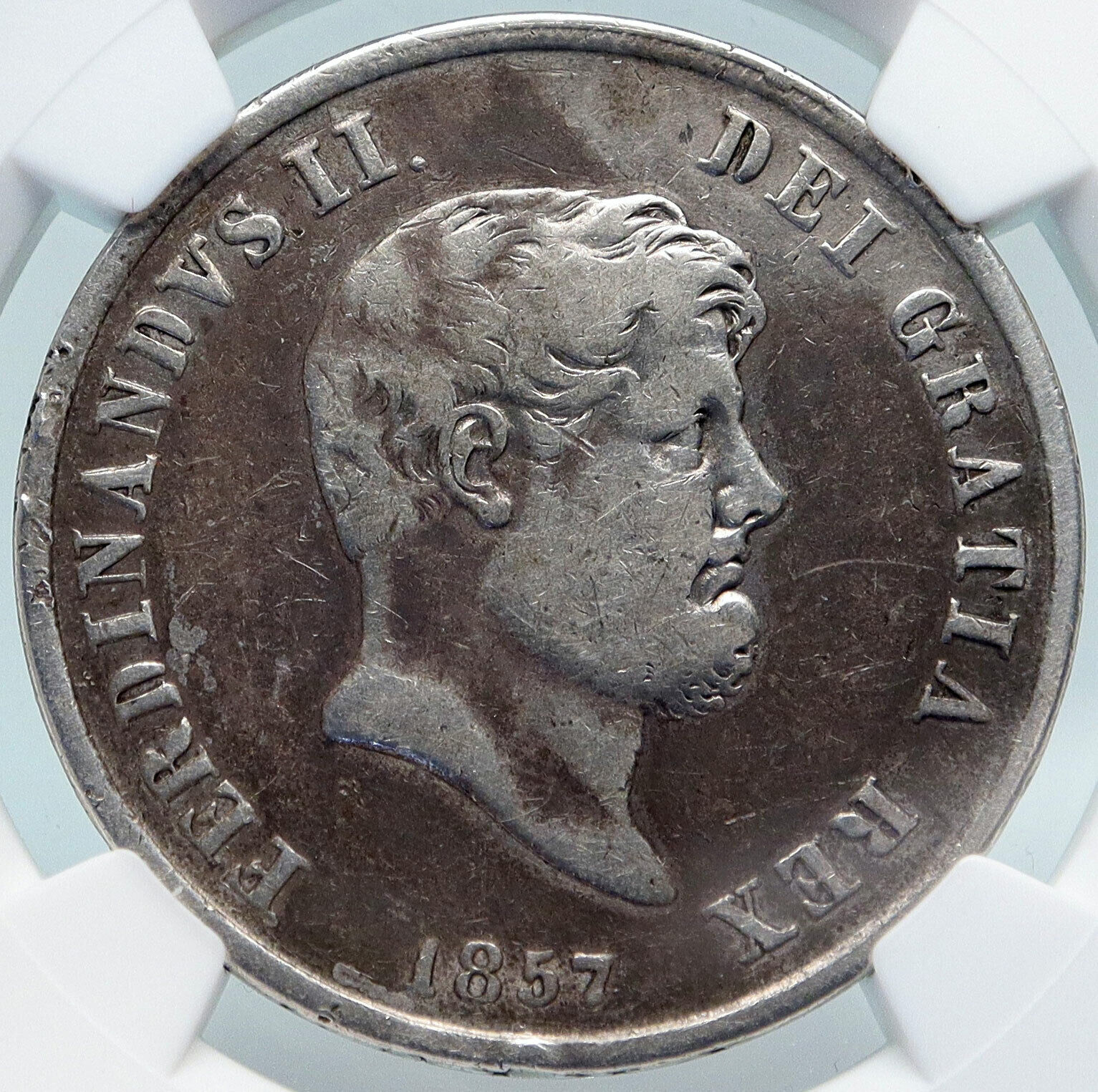|
Italy – Italian States – Lombardy
1848 Proof-like Silver 5 Lire 37mm (24.95 grams) 0.900 Silver (0.7234 oz. ASW)
Reference: C# 22
GOVERNO PROVVISORIO DI LOMBARDIA 5 LIRE ITALIAN, 1848, Value within wreath, date below.
ITALIA LIBERA DIO LO VUOLE M , Portrait of a female with scepter to right.
You are bidding on the exact item pictured, provided with a Certificate of Authenticity and Lifetime Guarantee of Authenticity.
Lombardy (Lombard and Italian: Lombardia) is one of the twenty administrative regions of Italy. It has an extent of 23,844 km2 (9,206 sq mi) in the northern-central part of the country, and a population of about 10 million people, constituting more than one-sixth of the population of Italy. Over a fifth of the Italian gross domestic product is produced in the region.
The metropolitan area of Milan is the largest in the country, and is among the largest in the European Union. Of the fifty-eight UNESCO World Heritage Sites in Italy, ten are in Lombardy. Virgil, Pliny the Elder, Ambrose, Caravaggio, Claudio Monteverdi, Antonio Stradivari, Cesare Beccaria, Alessandro Volta, Alessandro Manzoni, and popes John XXIII and Paul VI are among those with origins in the area now known as Lombardy.
The word Lombardy comes from Lombard, which in turn is derived from Late Latin Longobardus, Langobardus (“a Lombard”), derived from the Proto-Germanic elements *langaz + *bardaz; equivalent to long beard. Some scholars suggest the second element instead derives from Proto-Germanic *bardǭ, *barduz (“axe”), related to German Barte (“axe”) or that the whole word comes from the Proto-Albanian *Lum bardhi “white river” (Compare modern Albanian lum i bardhë).
During the early Middle Ages, “Lombardy” referred to the Kingdom of the Lombards (Latin: Regnum Langobardorum), a kingdom ruled by the Germanic Lombards who had controlled most of Italy since their invasion of Byzantine Italy in 568. As such “Lombardy” and “Italy” were almost interchangeable; by the mid-8th century the Lombards ruled everywhere except the Papal possessions around Rome (roughly modern Lazio and northern Umbria), Venice and some Byzantine possessions in the south (southern Apulia and Calabria; some coastal settlements including Amalfi, Gaeta, Naples and Sorrento; Sicily and Sardinia). The term was also used until around 965 in the form Λογγοβαρδία (Longobardia) as the name for the territory roughly covering modern Apulia which the Byzantines had recovered from the Lombard rump Duchy of Benevento.
Kingdom of the Lombards
During and after the fall of the Western Empire, Lombardy suffered heavily from destruction brought about by a series of invasions by tribal peoples. The last and most effective was that of the Germanic Lombards, or Longobardi, whose whole nation migrated here from the Carpathian basin in fear of the conquering Pannonian Avars in 568 and whose long-lasting reign (with its capital in Pavia) gave the current name to the region. There was a close relationship between the Frankish, Bavarian and Lombard nobility for many centuries.
After the initial struggles, relationships between the Lombard people and the Latin-speaking people improved. In the end, the Lombard language and culture assimilated with the Latin culture, leaving evidence in many names, the legal code and laws, and other things. The genes of the Lombards became quickly diluted into the Italian population owing to their relatively small number and their geographic dispersal to rule and administer their kingdom. The end of Lombard rule came in 774, when the Frankish king Charlemagne conquered Pavia, deposed Desiderius, the last Lombard king, and annexed the Kingdom of Italy (mostly northern and central present-day Italy) to his newly established Holy Roman Empire. The former Lombard dukes and nobles were replaced by other German vassals, prince-bishops or marquises.
Communes and the Empire
 In the 10th century, Lombardy, although formally under the rule of the Holy Roman Empire like much of central and northern Italy, was in fact divided in a multiplicity of small, autonomous city-states, the medieval communes. The 11th century marked a significant boom in the region’s economy, due to improved trading and, most importantly, agricultural conditions, with arms manufacture a significant factor. In a similar way to other areas of Italy, this led to a growing self-acknowledgement of the cities, whose increasing richness made them able to defy the traditional feudal supreme power, represented by the German emperors and their local legates. This process reached its apex in the 12th and 13th centuries, when different Lombard Leagues formed by allied cities of Lombardy, usually led by Milan, managed to defeat the Hohenstaufen Emperor Frederick I, at Legnano, but not his grandson Frederick II, at Battle of Cortenuova. Subsequently, among the various local city-states, a process of consolidation took place, and by the end of the 14th century, two signoria emerged as rival hegemons in Lombardy: Milan and Mantua.
Renaissance duchies of Milan and Mantua
In the 15th century, the Duchy of Milan was a major political, economical and military force at the European level. Milan and Mantua became two centres of the Renaissance whose culture, with men such as Leonardo da Vinci and Mantegna, and works of art (e.g. Leonardo da Vinci’s The Last Supper) were highly regarded. The enterprising class of the communes extended its trade and banking activities well into northern Europe: “Lombard” designated the merchant or banker coming from northern Italy (e.g. Lombard Street in London). The name “Lombardy” came to designate the whole of Northern Italy until the 15th century and sometimes later. From the 14th century onwards, the instability created by the unceasing internal and external struggles ended in the creation of noble seigniories, the most significant of which were those of the Viscontis (later Sforzas) in Milan and of the Gonzagas in Mantua. This richness, however, attracted the now more organised armies of national powers such as France and Austria, which waged a lengthy battle for Lombardy in the late 15th to early 16th centuries.
Late-Middle Ages, Renaissance and Enlightenment
After the decisive Battle of Pavia, the Duchy of Milan became a possession of the Habsburgs of Spain: the new rulers did little to improve the economy of Lombardy, instead imposing a growing series of taxes needed to support their unending series of European wars. The eastern part of modern Lombardy, with cities like Bergamo and Brescia, was under the Republic of Venice, which had begun to extend its influence in the area from the 14th century onwards (see also Italian Wars). Between the middle of the 15th century and the battle of Marignano in 1515, the northern part of east Lombardy from Airolo to Chiasso (modern Ticino), and the Valtellina valley came under possession of the old Swiss Confederacy.
Pestilences (like that of 1628/1630 described by Alessandro Manzoni in his I Promessi Sposi) and the generally declining conditions of Italy’s economy in the 17th and 18th centuries halted the further development of Lombardy. In 1706 the Austrians came to power and introduced some economic and social measures which granted a certain recovery.
Austrian rule was interrupted in the late 18th century by the French armies; under Napoleon, Lombardy became the centre of the Cisalpine Republic and of the Kingdom of Italy, both being puppet states of France’s First Empire, having Milan as capital and Napoleon as head of state. During this period Lombardy took back Valtellina from Switzerland.
Modern era
The restoration of Austrian rule in 1815, as the Kingdom of Lombardy–Venetia, was characterised by the struggle with the new ideals introduced by the Napoleonic era.
The popular republic established by the 1848 revolution was short-lived, its suppression leading to renewed Austrian rule. This came to a decisive end when Lombardy was annexed to the Kingdom of Italy 1859 as a result of the Second Italian War of Independence from the Austrian Empire. When annexed to the Kingdom of Italy in 1859 Lombardy achieved its present-day territorial shape by adding the Oltrepò Pavese (formerly the southern part of Novara’s Province) to the province of Pavia.
|












